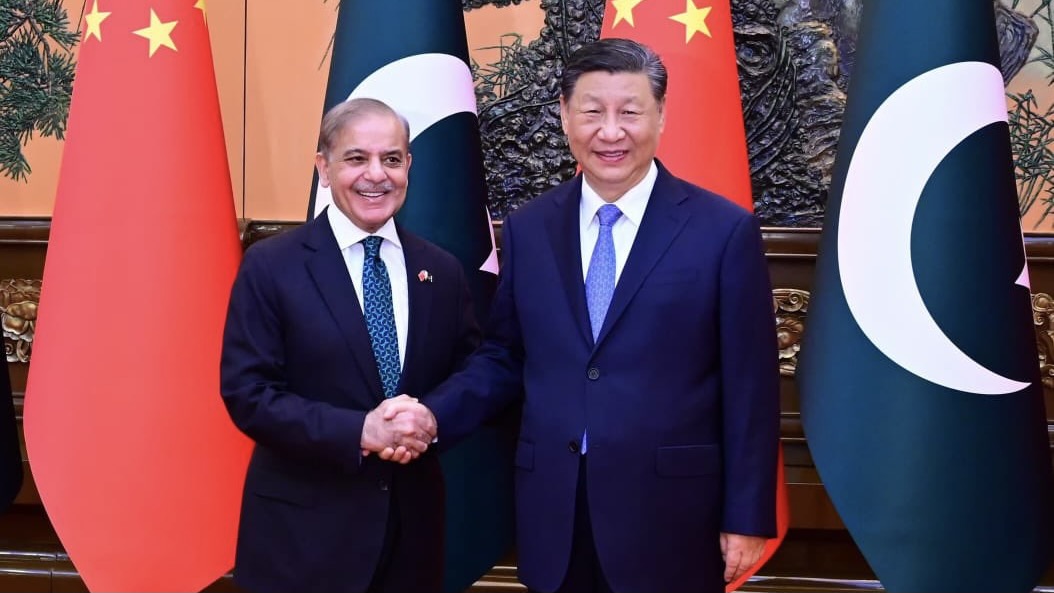Pakistani Prime Minister Shehbaz Sharif visited China last week with a large delegation, seeking to enhance economic and political relations between the countries. One of the stated goals of the visit was to upgrade the multi-billion dollar China Pakistan Economic Corridor (CPEC).
This is Sharif’s first official visit to China after being re-elected as prime minister in March. He arrived in China on Tuesday June 4 and was there until Saturday June 8. During his visit he visited several Chinese cities, meeting with members of the business community and top like President Xi Jinping and premier Li Qiang in Beijing.
On Wednesday, addressing a Pakistan-China business forum in Shenzhen in China’s Guangdong province, Sharif assured that his country will make all efforts to provide security to Chinese investors and workers in the country.
Security of the Chinese workers involved in CPEC projects is one major issue of concern. In March, at least five Chinese nationals were killed along with their Pakistani driver near one of the China-funded hydropower project sites in Khyber Pakhtunkhwa (KP) province. Such attacks have raised serious doubts over the fate of the project.
The Pakistan government is also seeking greater cooperation in the field of new technologies with China. Sharif invited Huawei, one of the world’s largest digital technology companies, to play a greater role in the country’s attempts to modernize governance, taxation, and its ambitious Safe City Project.
The “Safe City Project” is a proposal to increase security in Pakistan’s major cities through the use of cameras, digital technology, and artificial intelligence.
Pakistan is seeking greater investments in the field of manufacturing and technology along with better utilization of the special economic zones created along the CPEC from China. Development of the agricultural sector was another major agenda of the trip as China is one of the main markets for Pakistan’s agricultural products.
Pakistan will follow Chinese development model
During his meeting with members of the business community in Shenzhen, Pakistani PM Sharif lauded the Chinese model of development and said that “I will go back to Pakistan with this resolve, come what may, we will follow this model of great economic transformation in Pakistan. This model is enough to copy and simulate if we are sincere to our purpose and people,” Dawn reported.
Participated in Pak-China Business Forum in Shenzhen where I joined top business executives from both China and Pakistan.
Highlighted bilateral trade and investment potential, esp. in key sectors e.g. transfer of Chinese technology, industry & partnership in IT, agriculture,… pic.twitter.com/h01oVXNtvG
— Shehbaz Sharif (@CMShehbaz) June 5, 2024
Sharif in his signed article in Global Times on Wednesday June 5 claimed that China and Pakistan are “all weather strategic cooperative” partners. He claimed that his country seeks to enhance economic cooperation in all possible fields including technology and agriculture. Sharif underlined that his country “shares China’s vision when it comes to promoting international peace and regional stability, advancing sustainable development and committing to true multilateralism for a more equal, prosperous and peaceful world.”
Both the countries have a long history of cooperation in the international arenas. Both are members of Shanghai Cooperation Organization (SCO) as well.
China has been Pakistan’s biggest trade partner for years now, being the largest recipient of Pakistan’s exports and being the largest exporter to Pakistan. In 2021 the bilateral trade was close to USD 28 billion. It came down to nearly USD 21 billion in 2023.
Launched in 2013, the CPEC is a part of China’s ambitious Belt and Road Initiative (BRI) which directly links it with the Arabian sea at Pakistan’s Gwadar. The over USD 60 billion project includes building of roads, ports, power stations, and advanced means of communication such as rail lines, metros and airports all across Pakistan.
Some of the CPEC projects have already been completed. Recently, Pakistan inaugurated its first Metro rail project in Lahore. The Gwadar port is partially operational as well. On Wednesday, one of the airports built through the Chinese partnership in Gwadar started trial operations. However, some of the projects have suffered delays and setbacks due to internal political unrest in Pakistan following the coup against Imran Khan as well as the COVID-19 pandemic. This has invited global attention with the commentators in the west terming CPEC as Chinese “debt trap” for Pakistan.
Both China and Pakistan have rejected such claims and emphasized that CPEC is a mutually beneficial project with greater benefits for Pakistan in particular given its fragile economic situation. Infrastructure development and job creation are two major focus areas of CPEC. According to different reports, projects under CPEC have generated nearly 300,000 direct jobs so far with a potential of several times more indirect jobs. It has boosted local economic activities in the project areas as well.





